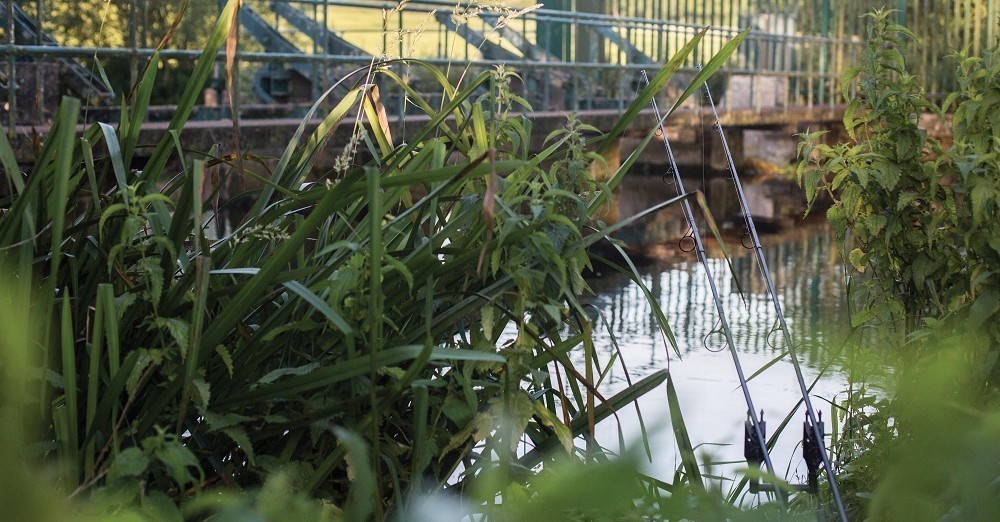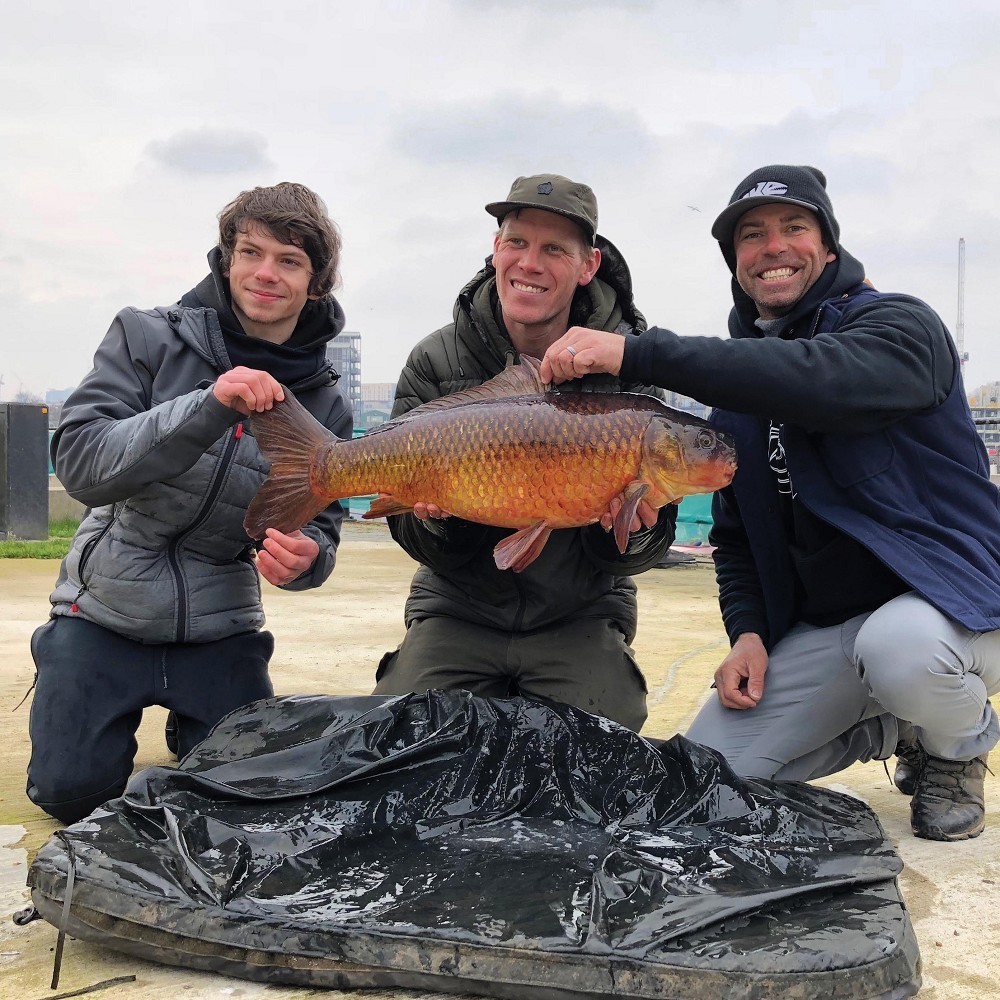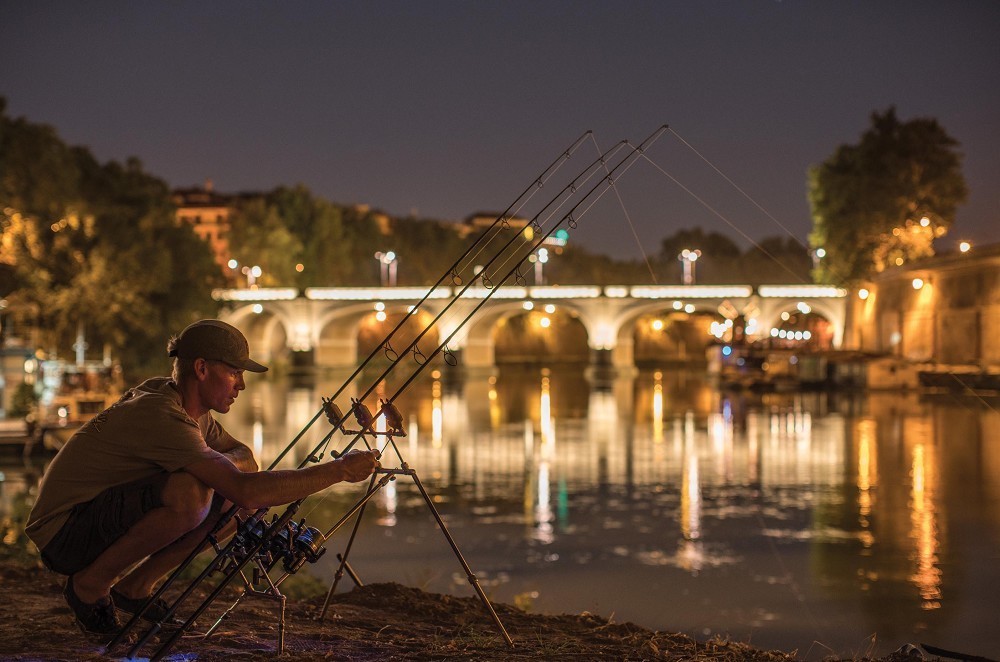
River carp fishing with Alan Blair
How Alan goes about catching carp from his favourite type of venue...
So from a very early age, I had a basic understanding of rivers, of currents and flows, eddies and slacks, creases and bends, deep and shallow. Watercraft on a river is very different to that on a stillwater; the fish are in different places at different times of year and for different reasons, and are dependent on conditions and levels. You definitely have to be on your toes more for river fishing, even with things like redoing your rigs. On a lake, in the majority of situations you can leave your rig in position for 24hrs. Rarely on a river do you get that opportunity and regular recasting is often necessary because of debris coming down with the flow, sometimes as often as every few minutes.
I progressed from the stick float to the quiver tip, catching bigger fish like chub and bream, but river carp were quite mythical creatures, and you rarely saw one. Just occasionally if you were lucky, you got a glimpse, and once or twice I hooked something unstoppable on my light leger gear; I badly wanted to catch one and an obsession was born!
The Key To Success
There are two real keys to success when river fishing for carp. First you need to understand where they want to spend their time; that was a massive lesson for me. I remember many times being naďve and reading books by the likes of John Wilson that advised you to look for marinas or overhangs and the like, and not actually following the behaviour of the carp.
Over the course of a few seasons I learnt that it’s not always about the textbook clichés. They don’t always live in the marina or under the big willow, they actually live where they want to live and that can be just because it’s off the beaten track and quiet, or it might be where the river is deeper or shallower. Sometimes there doesn’t appear to be any reason, other than that is where they want to be, and what I’ve learned is that that is the first step and this can take quite some time to work out. It’s not a case of going there once and seeing a few, and thinking ‘this is where they live’, you need to repeat that process in different conditions and keep seeing them in the same area.
Once you’ve cracked that, then that’s it, you have indeed, cracked it! Once you’ve found where they want to spend their time it can actually be quite easy. I’ve had many big results from quick overnighters, catching fish because I’ve invested a huge amount of time prior to that, and understanding where they want to be.
There is another way, but it’s much more long-winded and it’s not as good. Of course, if you bait a spot every day with say 20, 20mm boilies for two months, then they will come to you, but I’d rather invest the time in finding them and then put the bait in. Basically, if you find them there and they are happy that first night, and you put 20 boilies there, they’re going to drop down and eat them. You only have to do that two or three times to give them confidence, then put a rig in and start wading through that particular shoal of carp, catching them. I’m sure that’s what I’ve done: caught the ones in that little bit and then you move on to the next stretch.
So you have to find them, that’s the second key and that involves a lot of walking or cycling, or even boating. We’re talking potentially miles and miles of exploring. Walking and climbing trees is all well and good, but if you can use a boat it’s a massive edge.
Last year I walked a stretch that I hadn’t fished for a couple of years, and I saw next to nothing. I knew otters were present; I’d seen them there and I wondered if they’d emptied it. I decided to have a look from the boat and so with the girls in tow, I blew up the big rib and we went looking. Within a mile we’d found them everywhere; I just couldn’t see them from the bank with the glare of the sun, the weed and the bankside rushes. From the boat in the centre of the river I could see them in ones and twos, and also in groups.
Going for a paddle on a nice sunny day, in a boat or a kayak, will really teach you the full potential of your stretch. You can use an aquascope or goggles to really identify feeding areas. Of course we’re not talking about the likes of the Trent here, rather medium to small rivers that tend to be clearer, with the carp visible, at least some of the time.
The Freedom
Part of what I love about river fishing is the freedom to do this type of thing. No one is going to tell me I can’t use a boat or a certain bait. If you go to a commercial fishery you have to abide by the rules, and that’s the one thing that keeps me going back: the freedom… I really hate rules! It’s rare to find a stretch that’s bailiffed properly and for the most part they are unmanaged and/or unmanageable. Often there are no proper swims; it’s real and raw. It’s not that I want to fish for unnamed carp; I don’t really care about that, it’s more for me about fishing how I want to, against the fish, which is rare in this day and age. It’s a great feeling to know that no one has been in your swim the day before and already caught the fish, or put bait in. You still have to share sure, but having moved down to Essex ten years ago, where every syndicate is full with a waiting list, and where every club is busy, but for some reason the rivers aren’t. The anglers that I’ve met on the rivers tend to be of the same mindset anyway, so you immediately get on and know to give each other the courtesy of a little bit of space. I wasn’t around in that era, but it very much feels like that old school unwritten code of etiquette is still in effect. I’ve never been secretive with my captures and likewise, anglers are willing to share details of theirs to build up a collective knowledge. It’s a great environment both in terms of the fishing and the other anglers that you meet.
I’m blessed to have fished rivers all over the world and they couldn’t be more different in terms of size. I’ve fished some of the smallest streams and caught some banging carp from them. I’ve fished the likes of the Ouse and the Chelmer, those medium-sized rivers, and then the likes of the Trent. Then obviously over in Europe we’ve fished some absolute monsters, the likes of the Seine and the Danube; all of them give me the same buzz. Whether you’re fishing a tiny stream for a 12lber or a giant stretch of water for a monster, they’re all the same to me: you have water flowing through and you have to apply watercraft.
Baits In Position
So I’ve found the carp, identified where they’re happy, fed them a little bit of bait and it’s time to get the rods out. Wherever possible, I’ll be looking to present my hookbaits in the nearside margin where it’s easy for me to bait and position the rig. If I have to, for whatever reason, I will fish down the central channel, but I see no point in fishing across to the far margin. If I have to because there is a particular snag tree or feature, I will go round there and fish off the rod-tip. I want to keep it nice and easy.
All my river fishing over the last 10 years has been nothing, but quick overnighters. In many instances I arrive in the dark and pack up first thing in the morning to go to work, and we’re talking a handful of sessions each season. I haven’t got the time to be messing around; I want to turn up with my hookbait attached, lower it in with a handful of bait and sit back. Ultimately, it’s really simple fishing if you get the location part right.
In my dream scenario I’ll have the rig on the spot, pinned down and protected by a length of Cling-On Leader, and back to a heavy backlead under the rod-tip just protruding over the edge of the bank. This’ll keep most of my line out of the flow and reduce the chance of it picking up too much debris, with it also being pinned down nearer the rig and concealed from the carp. I’ll use a big inline lead and a normal length hooklink. If I can’t backlead for whatever reason, then I’ll fish a long hooklink to separate it and the leader coming up off the river bed. The closer they are together, the cagier and more spooky the fish will be, and for that reason I try and create that separation. I will also use a different lead set-up, with a lead clip and large tractor lead.
With baiting I’ll get the fish to clear the spots off for when I fish. There tends not to be loads of polished spots like on your local syndicate or day ticket lake. The fish are not battering the bottom for food in one area, they tend to graze more widely without anglers’ food and pressure. I will look for a presentable area to fish a rig over and then I’ll clean it off.
To clear it I’ll bait two or three times with a mix of pellet, hemp, maggots and groundbait, anything that’ll get as many different fish species on there to take it down to a clean, polished area - I don’t want any twigs or debris that hasn’t been washed away. Then I’ll introduce some big boilies, 20 and 24mm, to then avoid the attentions of the nuisance species and ensure that the carp get some. Even then, the greedy chub can give you the odd problem; their mouths are that big. The bream and tench however, struggle to eat them, and you don’t need a lot. I’m not fishing for a big, hungry shoal, just for a bite. Only a little bit of bait, regularly, every day if possible, but at least every couple of days… the more often, the better.
The End Tackle
So the fishing is simple, and the baiting is too. Likewise, my rigs are pretty straightforward. The main thing is that they are strong and reliable. Come June 16th the rivers are full of weed, fully grown and reaching the surface in places. You have big strands of lilies and beds of cabbage weed, and jungles of streamer weed to contend with; add these to savage snags, and in the more urban areas, structures of concrete and metalwork and with mussels that will slice your line like cotton. I need to hook the fish, but also to ensure I land them too.
Anyone who’s done any river fishing will know the carp tend to fight much harder than their stillwater cousins; they’re wild and angry! So it’s big hooks, strong hooklinks and a Cultured Hookbaits - they’re mega-effective wherever you take them, but nowhere more so than on the river. The coating on them releases attractors for around six hours, so it’s a bit like fishing paste, which is deadly effective when fishing rivers. That leakage carried downstream will grab the attention of any fish and draw them up to the bait and rig.
I fish strictly bottom baits, no wafters and pop-up rigs. I want them pinned down on the deck not waving about in the flow. It’s not about rigs; the emphasis really is on tracking the carp down.
Tidal Rivers...
Another thing to take into account is that some rivers are tidal. There’s a funny story as an example…
When I first moved to Essex, before I really got to know Kevin and Gary (Bayes), I was itching to go fishing. My good pal Reedy also worked there and we decided we would go, and our first port of call was Baysey. Gary loves his fishing – in fact he is borderline obsessed. If you get into a conversation with him about fishing in the local area, it can last an hour. One of these conversations started, and some 150 venues later we’d whittled it down to a stretch of river close to the office. His friend had had carp to 26lb and he’d personally caught them to mid-doubles. What really got us interested though, being as it was approaching winter, was when he said that we were a guaranteed bite. There were that many carp, he said, you just have to go and fish it and you will catch.
Anyway, Reedy and I headed down there, parked in the lay-by, cut through the bushes and arrived at what was a very small river. It was dark and we’d been at work so we quickly set-up, positioned the rods and went to bed shattered. Later that evening, around midnight, we both woken up to a series of bleeps. The water was a couple of inches from coming over our bedchairs and all the rods were now underwater! Luckily we were both using Nash butt locks and they were the only things keeping the rods from being washed away… we’d been completely flooded out! What Gary had failed to tell us was that it was a tidal river, and the tide had come in and the water level had risen significantly. I didn’t see the funny side at the time, but I didn’t lose my temper. Reedy however, completely blew his top! He’s the kind of guy that if his tubing isn’t threaded before he goes, he won’t go fishing, so to have all his gear knackered by the flood wasn’t funny for him! We ended up having to pack up, leaving our bite alarms there completely underwater and retrieving them the following day, going back into work very jarred off.
The next morning I rang Gary and said, “What the hell…” and he just laughed down the phone. It was a complete and utter stitch-up and typical of Bayesey. He thought it was hilarious that these two naďve youngsters from the Midlands had fallen for it.
After that I did fish the river a number of times and it was brilliant. It was pretty bland, but this particular stretch had a couple of bridges that the fish loved. When they created them the river was excavated slightly deeper and that extra foot of depth meant the fish had cover and sanctuary, and most importantly, that extra depth. Obviously the start of the tide is important, especially on larger rivers, but because of my lack of time, I can only go when I can go. What I do prefer on any tidal stretch is to fish it on low tide, and that’s purely because I’m more likely to be able to see the fish. When there is only a few feet of water in the river, then I can locate them easily, I don’t know if it’s the best for actually catching them. It might be better on either a rising or falling tide, but all I know is that low tide makes their location easier, and if I can find them, I can catch them.
You need to understand that river carp and particularly tidal river carp are scratching an existence. They’ve ended up in this changing environment because of floods, not through choice, but because they’ve gone over a weir-sill or through a lock gate. They don’t necessarily thrive but they adapt and survive, managing to battle the elements and to me, it’s some of the most exciting fishing I’ve ever done, as in amongst the carp you have bass, mullet and flounder and other saltwater species also living on the edge of their own natural environment. It’s so rewarding to catch a wild fish from this environment. It’s brutal!
Catching them is no different to doing so from the non-tidal stretches though. If I haven’t stalked them or sight-fished for them, then it’s been through pre-baiting and trickling in a little bit of bait, then rocking up and catching them.
One of the questions I get asked most often is, “How do I catch a river carp?” I hope then, that this piece helps in some way, but I can’t emphasise enough that it’s not about fancy rigs and it’s not about throwing in five kilos of boilies every night. It’s about tracking the fish down. It’s about getting your glasses on, or maybe putting a boat on the water and going out exploring…










